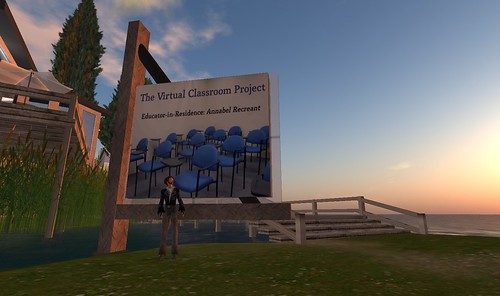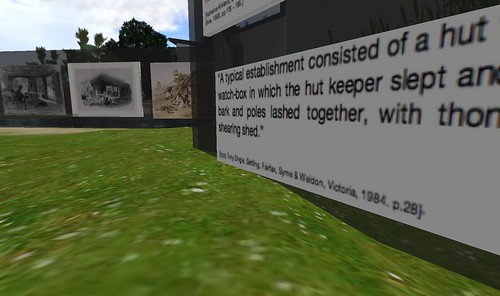The Living and Learning with New Media (Ito, Horst, Bittani, et al., 2008) report was published in November 2008. I read it right away in its entirety and have been thinking about it ever since. Specifically, I've been thinking about how the findings of this project can assist teachers and teacher educators. What, I kept asking myself, can educators learn from this report? More importantly, how can these lessons then be applied in our classrooms and teacher education programmes?
As I read and re-read this document I kept returning to its final section, "Conclusions and Implications." The final heading in this section struck a chord because it closely aligns with my doctoral research study and my current interest in assessment. The authors of the study state:
We see peer-based learning in networked publics ... in these settings, the focus of learning and engagement is not defined by institutional accountabilities but rather emerges from kids' interests and everyday social communication (Ito, Horst, Bittani, et al., 2008, p.38).
The study then goes on to state that "peers are an important driver of learning" (p.39) - not a revolutionary statement by any means, but important here in the light of what follows:
When these peer negotiations occur in a context of public scrutiny, youth are motivated to develop their identities and reputations through these peer-based networks, exchanging comments and links and jockeying for visibility. These efforts at gaining recognition are directed at a network of respected peers rather than formal evaluations of teachers or tests (p.39).
It's not surprising that interactions with peers and even adults in an interest-driven community are more engaging and more fulfilling than traditional classrooms where teachers and their textbooks and tests are often presented as more important than independent thinking and personal growth. Motivation emerges from interactions that take place online where anyone can see and participate in them. This "context of public scrutiny" is of great importance here. The safety of the self-contained classroom, one separated (by walls and firewalls) from the rest of the world - the world we are supposed to prepare our students for - goes against everything that surrounds young people today and prevents them from learning how to navigate the complex online world. Instead of separating our students from the world they're getting ready for, instead of cocooning them in protected classrooms, we need to give them opportunities to learn from and with people who share their passions. We need to give them access to communities "where they can find role models, recognition, friends, and collaborators who are co-participants in the journey of growing up in a digital age" (p.39).
What this means to me is that we need to seriously re-think not only our classrooms (we've known that for a while), but also, more importantly, our assessment and evaluation practices.
According to the report, we need to give our students access to "passionate hobbyists and creators" who share their work and passion in interest-driven communities, and who are valuable educationally because "youth see them as experienced peers, not people with authority over them"(p.39). Clearly, reducing access to these communities and the interactions they afford to letter or percentage grades is going to make our practices not only irrelevant but also, frankly, irresponsible. Opening up our classrooms to allow interest-driven interactions with people who "are not authority figures responsible for assessing kids' competence, but are rather what Dilan Mahendran has called 'co-conspirators'" (p.39) means that we have to start thinking very seriously about preparing our students for these interactions and helping them reflect on and learn from them.
How do we do it?
Some suggest that the tools teens embrace outside of school need to play a more prominent role in the classroom. Yes, these tools can help promote meaningful interactions, self-expression, and reflection. But let's not forget that merely bringing Web 2.0 tools into the classroom misses the point. Yes, they do promote peer-based interactions and self-expression. But adding blogging or wikis or even global collaborative projects to our curricula is not going to magically transform our static classrooms into interest-driven communities, and it certainly is not going to prepare the students to safely and effectively navigate "networked publics" (Ito, Horst, Bittani, et al., 2008, p.8). These tools are not going to magically create interest-driven communities. I have visited eight classrooms over the past four months, and in all but one I was shown both a class blogging community (or an online collaborative project) and also a list of teacher-generated prompts or assignments to be completed by each student for that very project. Will Richardson once referred to this as "assigned blogging" and, let me assure you, the phenomenon is alive and well.
I don't mean to say that there is no point in bringing technology into our classrooms. No, we have the responsibility to help our students learn how to effectively and safely use these new tools to extend and share their knowledge, make competent decisions, navigate "networked publics", and connect with those whose experiences can enrich their lives and their understanding of things they are passionate about. Our students need places where they can learn how to safely construct their online identities. They need to practice and acquire new media literacies. But the mere presence of technology in our classrooms is not going to help our students acquire these new literacies. Neither will using them to complete teacher-generated assignments. We have the responsibility to open up our walls and show our students that we want their passions and interests to grow beyond our physical classrooms, our class blogs, our textbooks, and our lesson plans. We also need to show them how to do it safely. It's time to reach beyond what we traditionally mean when we use the word "school."
But when our students reach beyond our classroom walls - even if it is with our permission or encouragement - we're not quite sure what to do. We stand there a bit sheepish, and we start thinking how to fit what they're doing into the course curriculum. How do we justify that brave act of opening our classroom walls? More importantly, how do we grade what the students have done? As Michael Wesch recently argued,
All of this vexes traditional criteria for assessment and grades. This is the next frontier as we try to transform our learning environments. When I speak frankly with professors all over the world, I find that, like me, they often find themselves jury-rigging old assessment tools to serve the new needs brought into focus by a world of infinite information. Content is no longer king, but many of our tools have been habitually used to measure content recall. For example, I have often found myself writing content-based multiple-choice questions in a way that I hope will indicate that the student has mastered a new subjectivity or perspective. Of course, the results are not satisfactory. More importantly, these questions ask students to waste great amounts of mental energy memorizing content instead of exercising a new perspective in the pursuit of real and relevant questions (Wesch, 2009).
In other words, "the pursuit of real and relevant questions" is too complex for our rubrics, checklists, and multiple choice quizzes. I believe that it demands that we get involved as co-investigators who assist students with their independent research and who also, through personal engagement as online learners and collaborators, model what it means to be successful as a learner. We have to become "co-conspirators" or, to use Vygotsky's famous term, "more capable peers," whose job is not to measure and evaluate but, primarily, to promote and support reflection and analysis in our students. As educators, we need to work on our role in the classroom as "passionate hobbyists and creators," we need to engage in learning in our classrooms, and in doing so we need to move towards a different model of assessment and evaluation.
"Become Students Again"
And that is precisely what I'm interested in - how do we redesign our outdated assessment and evaluation mechanisms to support our students as they venture outside of our classrooms and into interest-driven online communities?
I suggest that we follow and support our students. This isn't just about granting them leave to learn from and with somebody else in some online community that we've approved. This is also about traveling with them, not to supervise or hold their hand, but to advise as more experienced peers - to explore, learn alongside them, and help them reflect on what they are learning. It's about creating classrooms where, as Michael Wesch recently said, we can "become students again, pursuing questions we might have never imagined, joyfully learning right along with the others" (Wesch, 2009). We need to be there for them to show them how to learn. We need to show them that we're learning too, online and off. We need to show them that we reflect and set goals. We need to model those processes and learn to support our students in these new environments and interactions. It is our responsibility to help our students understand that learning how to learn means acquiring "a collection of good learning practices ... that encourage learners to be reflective, strategic, intentional, and collaborative" (James et al., 2007, p.28). Teaching our students, not as whole grades, not as classes, but as individuals, how to learn in the world where knowledge resides in webs, nodes, and multifaceted connections and correspondences is now our greatest responsibility.
Of course, the biggest question for me right now is: what does all of this look like in practice?
__________
Bibliography:
Ito, M., Horst, H., Bittanti, M., Boyd, D., Herr-Stephenson, B., Lange, P. G., Pascoe, C. J., and Robinson, L. (2008). Living and learning with new media: Summary of findings from the digital youth project. The John D. and Catherine T. MacArthur Foundation Reports on Digital Media and Learning.
.
James, M. et al. (2007). Improving learning how to learn. Classrooms, schools, and networks. New York: Routledge.
.
Wesch, M. (2009, January 7). From knowledgeable to knowledge-able: Learning in new media environments. Academic Commons. Retrieved January 7, 2009, from http://www.academiccommons.org/commons/essay/knowledgable-knowledge-able


